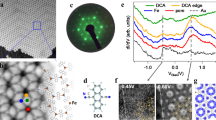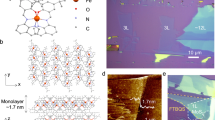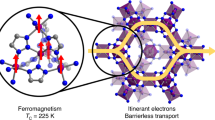Abstract
In recent years, research on spin ordering phenomena has broadened to include intermolecular exchange interactions in organic–inorganic crystals and goes beyond the traditional focus on interatomic interactions. However, a crystallized framework used for stabilizing parallel spin alignment through an ordered lattice is indispensable to ferromagnetism. Here we demonstrate room-temperature ferromagnetic order in two-dimensional confined molecule-based monolayers. The confinement effect of the van der Waals interlayer space enables cobaltocene molecules to self-assemble into a monolayer with a honeycomb-like configuration. The spontaneous uniform spin orientation—ferromagnetic coupling—is established by an intermolecular vibronic superexchange interaction, involving a cooperative dynamic Jahn–Teller effect in the confined cobaltocene monolayer. The molecular cobaltocene monolayers exhibit a ferromagnetic transition temperature above room temperature and have a large saturation magnetization.
This is a preview of subscription content, access via your institution
Access options
Access Nature and 54 other Nature Portfolio journals
Get Nature+, our best-value online-access subscription
$29.99 / 30 days
cancel any time
Subscribe to this journal
Receive 12 print issues and online access
$209.00 per year
only $17.42 per issue
Buy this article
- Purchase on Springer Link
- Instant access to full article PDF
Prices may be subject to local taxes which are calculated during checkout





Similar content being viewed by others
Data availability
All data generated or analysed during this study are included in this published article (and its Supplementary Information files). Source data are provided with this paper.
References
Aharoni, A. Introduction to the Theory of Ferromagnetism (Clarendon Press, 2000).
Cullity, B. D. & Graham, C. D. Introduction to Magnetic Materials (Wiley, 2011).
Heisenberg, W. Mehrkörperproblem und Resonanz in der Quantenmechanik. Z. f.ür. Phys. 38, 411–426 (1926).
Dirac, P. A. M. On the theory of quantum mechanics. Proc. R. Soc. Lond. Ser. A 112, 661–677 (1926).
Zener, C. Interaction between the d-shells in the transition metals. II. Ferromagnetic compounds of manganese with perovskite structure. Phys. Rev. 82, 403 (1951).
Anderson, P. W. Antiferromagnetism. Theory of superexchange interaction. Phys. Rev. 79, 350 (1950).
Griffiths, D. J. & Schroeter, D. F. Introduction to Quantum Mechanics (Cambridge Univ. Press, 2018).
Belov, K. P., Levitin, R. & Nikitin, S. A. Ferromagnetism and antiferromagnetism of rare-earth metals. Sov. Phys. Uspekhi 7, 179 (1964).
Kasuya, T. A theory of metallic ferro- and antiferromagnetism on Zener’s model. Prog. Theor. Phys. 16, 45–57 (1956).
Jonker, G. & Van Santen, J. H. Ferromagnetic compounds of manganese with perovskite structure. Physica 16, 337–349 (1950).
Lotgering, F. K. Ferromagnetism in spinels: CuCr2S4 and CuCr2Se4. Solid State Commun. 2, 55–56 (1964).
Witte, R. et al. High-entropy oxides: an emerging prospect for magnetic rare-earth transition metal perovskites. Phys. Rev. Mater. 3, 034406 (2019).
Gong, C. et al. Discovery of intrinsic ferromagnetism in two-dimensional van der Waals crystals. Nature 546, 265–269 (2017).
Huang, B. et al. Layer-dependent ferromagnetism in a van der Waals crystal down to the monolayer limit. Nature 546, 270–273 (2017).
Coomber, A. et al. Intermolecular interactions in the molecular ferromagnetic NH4Ni(mnt)2·H2O. Nature 380, 144–146 (1996).
Novoa, J. J., Deumal, M. & Jornet-Somoza, J. Calculation of microscopic exchange interactions and modelling of macroscopic magnetic properties in molecule-based magnets. Chem. Soc. Rev. 40, 3182–3212 (2011).
Fukunaga, H. & Miyasaka, H. Magnet design by integration of layer and chain magnetic systems in a pi-stacked pillared layer framework. Angew. Chem. Int Ed. Engl. 54, 569–573 (2015).
Ohkoshi, S. et al. Magnetic properties of mixed ferro-ferrimagnets composed of Prussian blue analogs. Phys. Rev. B 56, 11642 (1997).
Perlepe, P. et al. Metal-organic magnets with large coercivity and ordering temperatures up to 242°C. Science 370, 587–592 (2020).
Berezinskii, V. L. Destruction of long-range in one-dimensional and 2-dimensional systems possessing a continuous symmetry group 2 quantum system. Sov. Phys. Jetp-Ussr 34, 610 (1972).
Gibertini, M., Koperski, M., Morpurgo, A. F. & Novoselov, K. S. Magnetic 2D materials and heterostructures. Nat. Nanotechnol. 14, 408–419 (2019).
Goodenough, J. B., Wold, A., Arnott, R. & Menyuk, N. Relationship between crystal symmetry and magnetic properties of ionic compounds containing Mn3+. Phys. Rev. 124, 373 (1961).
Kugel, K. I. & Khomskiĭ, D. I. The Jahn–Teller effect and magnetism: transition metal compounds. Sov. Phys. Uspekhi 25, 231 (1982).
Englman, R. & Englman, R. The Jahn–Teller Effect in Molecules and Crystals (Wiley, 1972).
Garnica, M. et al. Long-range magnetic order in a purely organic 2D layer adsorbed on epitaxial graphene. Nat. Phys. 9, 368–374 (2013).
Tseng, T. C. et al. Charge-transfer-induced structural rearrangements at both sides of organic/metal interfaces. Nat. Chem. 2, 374–379 (2010).
Li, Z. et al. Confined synthesis of 2D nanostructured materials toward electrocatalysis. Adv. Energy Mater. 10, 1900486 (2019).
Lopez-Cabrelles, J. et al. Chemical design and magnetic ordering in thin layers of 2D metal-organic frameworks (MOFs). J. Am. Chem. Soc. 143, 18502–18510 (2021).
Manzeli, S. et al. 2D transition metal dichalcogenides. Nat. Rev. Mater. 2, 17033 (2017).
Sriv, T., Kim, K. & Cheong, H. Low-frequency Raman spectroscopy of few-layer 2H-SnS2. Sci. Rep. 8, 10194 (2018).
Lee, C. et al. Anomalous lattice vibrations of single-and few-layer MoS2. ACS Nano 4, 2695–2700 (2010).
Bersuker, I. B. Modern aspects of the Jahn–Teller effect theory and applications to molecular problems. Chem. Rev. 101, 1067–1114 (2001).
Zlatar, M., Schläpfer, C.-W., Penka Fowe, E. & Daul, C. A. Density functional theory study of the Jahn–Teller effect in cobaltocene. Pure Appl. Chem. 81, 1397–1411 (2009).
Seiler, P. & Dunitz, J. D. A new interpretation of the disordered crystal structure of ferrocene. Acta Crystallogr. Sect. B Struct. Crystallogr. Cryst. Chem. 35, 1068–1074 (1979).
Zhang, H., Yavorsky, B. Y. & Cohen, R. E. Polar metallocenes. Molecules 24, 486 (2019).
Sugimoto, T., Fujiwara, H., Noguchi, S. & Murata, K. New aspects of π–d interactions in magnetic molecular conductors. Sci. Technol. Adv. Mater. 10, 024302 (2009).
Sceats, E. L. & Green, J. C. Charge transfer composites of bis(cyclopentadienyl) and bis(benzene) transition metal complexes encapsulated in single-walled carbon nanotubes. Phys. Rev. B 75, 245441 (2007).
Briganti, M. et al. Mixed-sandwich titanium(III) qubits on Au(111): electron delocalization ruled by molecular packing. Nano Lett. 22, 8626 (2022).
Goodenough, J. B. Theory of the role of covalence in the perovskite-type manganites [LaM(II)]MnO3. Phys. Rev. 100, 564–573 (1955).
Kanamori, J. Superexchange interaction and symmetry properties of electron orbitals. J. Phys. Chem. Solids 10, 87–98 (1959).
Czap, G. et al. Detection of spin-vibration states in single magnetic molecules. Phys. Rev. Lett. 123, 106803 (2019).
Czap, G. et al. Probing and imaging spin interactions with a magnetic single-molecule sensor. Science 364, 670–673 (2019).
Baker, M. L. et al. K- and L-edge X-ray absorption spectroscopy (XAS) and resonant inelastic X-ray scattering (RIXS) determination of differential orbital covalency (DOC) of transition metal sites. Coord. Chem. Rev. 345, 182–208 (2017).
Blöchl, P. E. Projector augmented-wave method. Phys. Rev. B 50, 17953–17979 (1994).
Perdew, J. P., Burke, K. & Ernzerhof, M. Generalized gradient approximation made simple. Phys. Rev. Lett. 77, 3865–3868 (1996).
Kresse, G. & Furthmüller, J. Efficient iterative schemes for ab initio total-energy calculations using a plane-wave basis set. Phys. Rev. B 54, 11169–11186 (1996).
Kresse, G. & Hafner, J. Ab initio molecular dynamics for liquid metals. Phys. Rev. B 47, 558–561 (1993).
Grimme, S. et al. A consistent and accurate ab initio parametrization of density functional dispersion correction (DFT-D) for the 94 elements H–Pu. J. Chem. Phys. 132, 154104 (2010).
Steiner, S. et al. Calculation of the magnetic anisotropy with projected-augmented-wave methodology and the case study of disordered Fe1−xCox alloys. Phys. Rev. B 93, 224425 (2016).
Methfessel, M. & Paxton, A. T. High-precision sampling for Brillouin-zone integration in metals. Phys. Rev. B 40, 3616–3621 (1989).
Acknowledgements
This work was financially supported by the National Natural Science Foundation of China (grant nos. 21925110, U2032161, 21890751, 22272158, 22303092, 22225301 and 22321001), the National Key R&D Program on Nano Science & Technology of the Ministry of Science and Technology, China (grant no. 2022YFA1203601), the China Academy of Sciences (CAS) Project for Young Scientists in Basic Research (grant no. YSBR-070), University of Science & Technology of China (USTC) Research Funds of the Double First-Class Initiative (grant no. YD2060002004), the Youth Innovation Promotion Association, CAS (grant no. 2018500), the Strategic Priority Research Program, CAS (grant nos. XDB36000000 and XDB0450101), the Innovation Program for Quantum Science and Technology (grant no. 2021ZD0303302), the Key R&D Program of Shandong Province (grant no. 2021CXGC010302), the Users with Excellence Project of Hefei Science Center, CAS (grant no. 2021HSC-UE004), and the National Postdoctoral Program for Innovative Talents (grant nos. BX20190307 and BX20190308). We appreciate the support from beamline 1W1B of the Beijing Synchrotron Radiation Facility, Beijing, China, and beamlines BL12B-a and BL11U of the NSRL, Hefei, China. We thank the electron microscopy facility of the Cryo-EM Centre of USTC for their support and the super computer centres of USTC and CAS for their support. This work was partially carried out at the USTC Centre for Micro and Nanoscale Research and Fabrication.
Author information
Authors and Affiliations
Contributions
C.W. conceived the idea, experimentally realized the study, co-wrote the paper, supervised the entire project and is responsible for the infrastructure and project direction. Y.G. designed and experimentally realized the study, co-wrote the paper and supervised the entire project. Yuhua Liu, H.L., B.Y. and Yang Liu contributed equally to this work; they experimentally realized the study, analysed the data and co-wrote the paper. These works were assisted by J.P., Y.S., Y.Q., K.C., W.C., W.Y. and J.Z. The HAADF-STEM data collection was performed by Y. Lin. and X.T. Theoretical calculations were carried out by H.L. and X.W., Y.X. supervised the whole experimental procedure and co-wrote the paper. All authors discussed the results and commented on and revised the paper.
Corresponding authors
Ethics declarations
Competing interests
The authors declare no competing interests.
Peer review
Peer review information
Nature Physics thanks Lorenzo Poggini, Changgu Lee and the other, anonymous, reviewer(s) for their contribution to the peer review of this work.
Additional information
Publisher’s note Springer Nature remains neutral with regard to jurisdictional claims in published maps and institutional affiliations.
Supplementary information
Supplementary Information
Supplementary Figs. 1–10, Discussion and Tables 1 and 2.
Source data
Source Data for Figs. 2, 3 and 5
Data for Figs. 2a–c, 3a–f and 5b–d.
Rights and permissions
Springer Nature or its licensor (e.g. a society or other partner) holds exclusive rights to this article under a publishing agreement with the author(s) or other rightsholder(s); author self-archiving of the accepted manuscript version of this article is solely governed by the terms of such publishing agreement and applicable law.
About this article
Cite this article
Liu, Y., Lv, H., Yuan, B. et al. Room-temperature long-range ferromagnetic order in a confined molecular monolayer. Nat. Phys. 20, 281–286 (2024). https://doi.org/10.1038/s41567-023-02312-z
Received:
Accepted:
Published:
Issue Date:
DOI: https://doi.org/10.1038/s41567-023-02312-z



